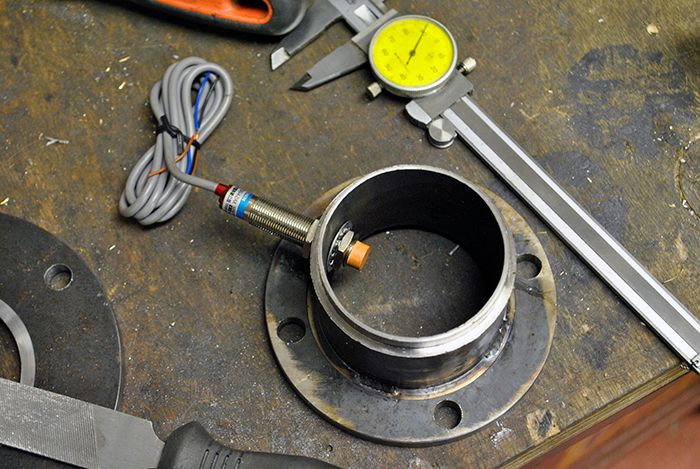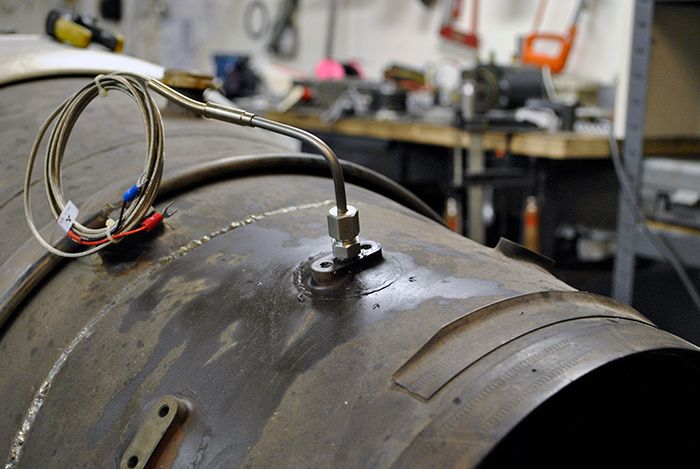nersut
Veteran Member
  
Joined: September 2012
Posts: 223
|
Post by nersut on Feb 10, 2015 5:19:46 GMT -5
Hey, you could maybe even use a simple microwave oven transformer (230V A.C. version) with pulsed (200/400Hz?) 12V D.C. input.  A normal microwave oven transformer produces around 2000V A.C. output when it's powered by 230V A.C. = 9 x step up. Car battery 12.6V x 9 = 113.4V... Close enough to 115V? Of course it will not be accurate but maybe worth trying? Cheers Erik |
|
jetric
Veteran Member
  
Joined: December 2014
Posts: 149 
|
Post by jetric on Feb 10, 2015 12:39:50 GMT -5
Hi Anders,
I had one of those 115v ac cracker boxes and the only usefull thing in it was the capacitor the rest of it went in the bin! there are three options open to you; you could get in touch with a guy here in the UK called harry on his web site 'jet engine trader' i know he has a few 24v cracker boxes for sale or i could make you one up for around £200 or you could use a long reach diesel car glow plug but you would have to make a boss the same shape as the original ignitor plug with a thread and bore to fit the glow plug through the centre of the boss so the end of the glow plug that gets red hot ends up in the same position as where the spark/ark would be on the original ignitor plug. if you where using the glow plug idea you'll have to wait about 30seconds after putting power to the glow plugs before spooling the engine over to start it in order to give the glow plug enough time to get red hot so they will ignite the fuel spray from the atomisers that warm up the hooked tube vaporisers in the flame tube, Oh and by the way have you primed the oil system that lubricates the centre and rear bearing before you spool the engine over because these bearings are total loss oil system fed by two small plunger pumps and any air in the oil lines takes quite a while to pump its way out before reaching the bearings this is a common killer of the second hand/surplus vipers that have been sitting around for years,
Rich.
|
|
|
|
Post by Johansson on Feb 10, 2015 14:20:10 GMT -5
Thanks Erik for the pics and ideas, I am a bit worried about cutting the box apart though since it might be filled with epoxy. I´ll ask my electronically skilled friends about the transformer idea, just reading about it makes my head hurt.  Rich: That is sad news but very appreciated, the glow plug idea is good and I don´t think I will have any problems making a custom boss for one. I´ll chew on this for a while and see what I decide to do. The oil system priming was very good to know about, I copied the text and made a list of things to do before the first start. You have probably saved me a bearing failure so thanks a lot for the info! Cheers! /Anders |
|
|
|
Post by finiteparts on Feb 11, 2015 21:51:47 GMT -5
|
|
|
|
Post by Johansson on Feb 11, 2015 23:56:08 GMT -5
Ah, so there is hope for the ignitor after all. Thanks!  |
|
|
|
Post by Johansson on Mar 18, 2015 1:23:22 GMT -5
Time to get this baby running!  I spent a couple of hours on it last night going over fittings, removing the fire detectact wire wrapped all around the engine and replacing nuts and bolts "borrowed" by Mr Everett assumingly. Pics will come tonight. There are two orange wires going into the combustor area from a box underneath the engine where the fire detectant wire connects, what is that all about? I will also pester you with some pics of hose fittings with nothing attached to them, hopefully we can figure out which ones that needs to be blanked off and which ones should be left open. Will continue digging through the 500 page manual tonight and print out pages that are useful. Cheers! /Anders |
|
|
|
Post by Johansson on Mar 18, 2015 4:37:15 GMT -5
Another question. If I want to make an air screen filter for the engine to avoid sucking gravel or small pets into the engine, what mesh size and surface area would I need to avoid choking the engine?  |
|
|
|
Post by Johansson on Mar 18, 2015 16:02:46 GMT -5
Last night I worked a bit on the Viper as I said earlier, the bike has consumed all spare time this winter since I had to get it ready for Speed Weekend but now it is about time to get this baby up and running!  The easiest way to get a tacho reading is to measure the revs on the starter coupling, I can then calculate the revs when I know the gearing ratio between the starter and engine. To do this I fitted an inductive sensor to the starter mount.  I threaded one of the thermocouple holes to accommodate a K-type thermocouple, the rest of the 6 holes will be sealed off later.  The thermocouple in place.  After that I spent almost three hours removing the fire wire that was wound all around the engine, by the way I just found in the manual that the two orange cables was a turbine overheat sensor so I answered my own question.   Now the engine is a bit more comprehensive to look at, later this week I will start making a dashboard for the engine controls and meters.  I´ve also replaced a handful of UNF nuts and bolts that were missing when I got the engine.  Cheers! /Anders |
|
|
|
Post by racket on Mar 18, 2015 16:26:10 GMT -5
Hi Anders You'll be needing some sort of bellmouth on the engine so that it can breathe properly , the FOD screening can be fitted around the OD of the bellmouth ,bellmouth OD twice diameter of first stage wheel , ........... you probably need at least twice the first stage comp wheel's inlet area for the freeflow area thru the mesh, I think I'd go somewhere closer to 4 times area, and it will need fairly substantial bracing under the mesh to prevent getting sucked into the engine from the pressure drop across the mesh . Found this in one of my texts  Cheers John |
|
|
|
Post by Johansson on Mar 19, 2015 4:47:41 GMT -5
Hi John, I´ve been thinking about making a bellmouth for the intake, but I cannot for my life figure out how to do one. Especially in metal, a glass fiber bellmouth is doable but my bench lathe is a tad too small for turning an aluminum one.  Do you happen to have the paper in better quality? It is a bit difficult to read unfortunately. Cheers! /Anders |
|
|
|
Post by racket on Mar 19, 2015 17:13:53 GMT -5
Hi Anders
Have a look for "cooling tower" bellmouths , or perhaps the hovercraft guys ..................what ID is the engine casing inlet?
The text in the pic is about unrelated stuff , the only useful bit is the pic of the bellmouth and screen to give you an idea of whats used for ground testing of engines to allow the engine to breath successfully and produce its design power .
Cheers
John
|
|
gidge348
Senior Member
  
Joined: September 2010
Posts: 426 
|
Post by gidge348 on Mar 19, 2015 21:01:56 GMT -5
Hi John, I´ve been thinking about making a bellmouth for the intake, but I cannot for my life figure out how to do one. Especially in metal, a glass fiber bellmouth is doable ............ Another option may be metal spinning if you know someone, but I think the best option is probably fibre glass unless you can locate one as John suggested. Cheers Ian... |
|
|
|
Post by enginewhisperer on Mar 19, 2015 22:10:50 GMT -5
I've seen a few industrial fans with bellmouth casings, and even some big metal lampshade type things that would be close - but you'd have to be pretty lucky to find something the right diameter  |
|
|
|
Post by Johansson on Mar 20, 2015 5:56:09 GMT -5
Perhaps a sheet metal cone will suffice, it will certainly improve air flow and it will be sturdy enough to fit the air screen to. I´ve been thinking about making a glass fiber one but I am nowhere near skilled enough with that stuff to make something that looks acceptable and has the desired strenght.
I won´t even have to run the engine to 100% so I think I can live with an a little bit less than optimal air intake, 3000lbs of thrust is more than I will ever need in case it ends up in a vehicle of some sort.
|
|
|
|
Post by frankenhealey on Mar 20, 2015 6:23:28 GMT -5
3000lbs of thrust is more than I will ever need in case it ends up in a vehicle of some sort. Anders, If you decided to 'vehiclize' it give me a shout as I know Mark Newby and Colin Fallows very well and I'll put you in touch. They ran two drag/lsr jet cars in the 90's, see here - www.thule.co.uk/partners/blsr.aspCheers, Ian |
|